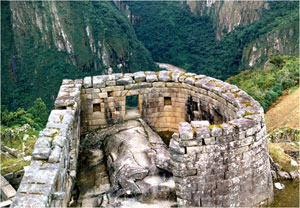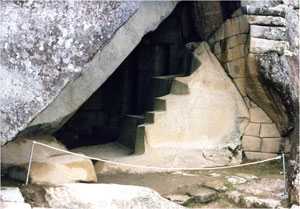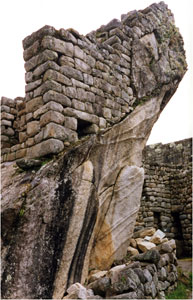Architecture & Nature

When Hiram Bingham discovered Machu Picchu on the 24th July 1911, it was covered with dense jungle, probably much as it had been before the Incas or whoever chose to build their city there. Bingham first saw the Inca terraces, beautifully arranged along the contours of the mountain, and he realised immediately the magnificence of the site, although vegetation covered practically all of it. The efficiency of Inca terrace design had been evolved through many generations and became an outstanding element in the urban landscape, especially in Machu Picchu.
The Incas always combined their ideologies with pragmatism. From what we see of it now, it is evident that Machu Picchu was very carefully planned. We know that the Incas used models, carved in stone, before laying out their settlements. They also used instruments for surveying and the plotting of right angles.
The Incas were also extremely economical in their use of land, especially at Machu Picchu; it was scarce, they could hardly afford to waste any space. The retaining walls formed terraces, which not only served agricultural purposes, but also helped avoid soil erosion thus becoming crucial elements in the overall composition. We have to imagine these terraces landscaped with plants and it is believed that they, especially those up Huayna Picchu – the peak at the far end – were used for experiments in the growing of crops at different levels. And no doubt there were rituals related to them.

Mountains were central to the religious system of the Incas. The spirits of the mountains were called Apu and at Machu Picchu they carved profiles of the distant mountains onto vertical flat stones so these reproductions could be worshipped.
They also believed that every object in nature, every piece of ground had a spirit with which they – the Incas – had to harmonise. If large rocks stood in their way, they were never demolished; on the contrary paths were built around them, buildings also follow natural forms, the contours, so Earth and the man-made structures seem to coalesce.
The most extraordinary examples of this integration between nature and architecture are found in the Royal Mausoleum (see picture above). Robert Venturi, who visited Machu Picchu, shows in his Complexity and Contradiction that in this structure, nature and architecture are so closely knitted together that one can hardly tell which is the one and which the other.
Bingham identified various sectors and groups that he found in Machu Picchu during his expeditions and those we use now are very much the same. There are two main sectors: the Agricultural and Urban whilst the latter is further divided into two, the Upper or Western Sector and the Lower or Eastern one.

There are 172 buildings in all, of which 66 are in the Upper Sector and 106 in the Lower Sector. The length of Machu Picchu is 530 metres from the main gate to the last building at the Sacred Rock before Huayna Picchu and the site is approximately 200 metres wide. It is believed that Machu Picchu held approximately 1,000 people and most of the remains have proved to be of women so historians believe that it was inhabited mainly by women and priests.
The original name is unknown. Machu Picchu is the name of the mountain on which the Citadel was built and in Quechua, the language spoken by the Incas it means:” Old Mountain.” Reinaldo Chohfi collected organic samples for carbon dating in the 1980s. He found 3 readings: one dated to 650 AD, a second to 1200 AD and a third to 1450 AD. He also found other dates from well before the Christian era, thought this was unlikely and decided to ignore them. Perhaps he was wrong.
We may never answer our questions as to who lived there, what they did and why they abandoned it. But we can be certain that whoever built it and lived there, inhabited one of the most beautiful places on Earth, where you can almost touch the rainbow with your hands (see Gallery). It’s a place of not just order with well defined boundaries, but also one of infinite beauty and mystery.
